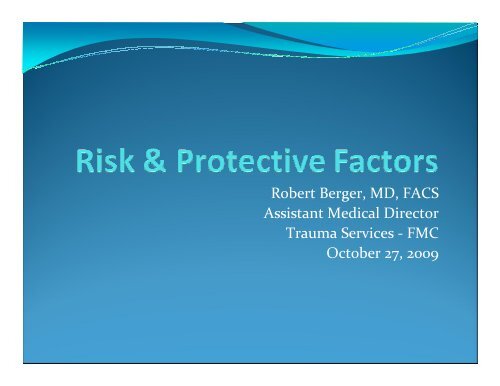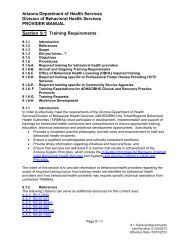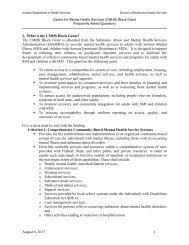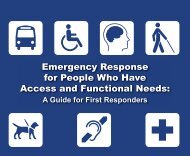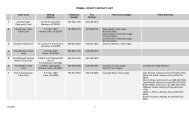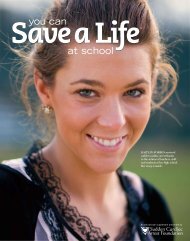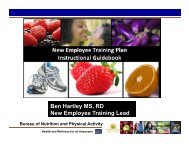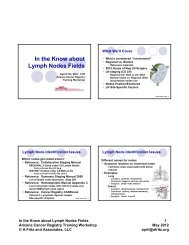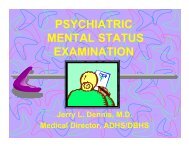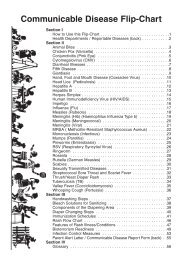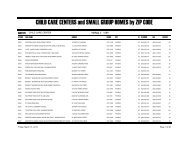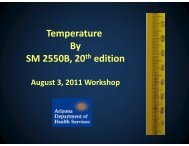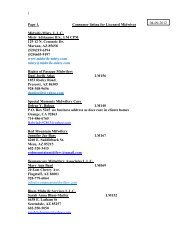Robert Berger, MD, FACS Assistant Medical Director Trauma ...
Robert Berger, MD, FACS Assistant Medical Director Trauma ...
Robert Berger, MD, FACS Assistant Medical Director Trauma ...
Create successful ePaper yourself
Turn your PDF publications into a flip-book with our unique Google optimized e-Paper software.
<strong>Robert</strong> <strong>Berger</strong>, <strong>MD</strong>, <strong>FACS</strong><br />
<strong>Assistant</strong> <strong>Medical</strong> <strong>Director</strong><br />
<strong>Trauma</strong> Services ‐ FMC<br />
October 27, 2009
• Are there really risks?<br />
• What increases the risks<br />
• Cases<br />
• Extremes of Age<br />
• Protective Factors<br />
• Recommendations<br />
Goals
Examples of Risks<br />
www.youtube.com
WEST VIRGINIA –ATV ACCIDENT<br />
CAPITAL<br />
• 8x natl average for death rate per‐capita<br />
• 2004‐2006: 112 fatal ATV crashes<br />
• 95% were drivers, 15% with helmets<br />
• 65% were head injuries after traffic collision<br />
• 55% were thorax/abd compression injuries after<br />
rollovers<br />
• ETOH in 50%, of those 88% avg 0.17<br />
• 21% positive test for other drugs<br />
Kaplan, et al., Fatal ATV crashes. Am J Prev Med. 2009 Apr;36(4);311‐6.
NEW ZEALAND ATV INJURIES<br />
• 2000‐2006, 218 cases<br />
• Mechanisms: Fall (48%), collision (31%), rolling (14%)<br />
• Mean age 9.9 yrs<br />
• Child was driver (53%), passenger (28%)<br />
• Mean ISS 7.9, LOS 2 days, Helmet use (14%)<br />
• OR (51%), ICU (7.8%), Disability (2.8%)<br />
• Deaths – 16 children<br />
• NZ Comparison – avg. age is less and shorter LOS<br />
Jones, et al., ATV injuries in New Zealand. N Z Med J. 2009 Sep 11;122(1302):11‐<br />
28.
FMC DATA<br />
• 1/2008 to 9/2009<br />
• 134 pts, Avg age 31<br />
• 60 = 10 (7%)<br />
• 20% intoxicated<br />
• Direct to OR 25 (19%)<br />
• Direct to ICU 17 (13%)<br />
• Avg LOS 4.12 days<br />
• Deaths ‐ 2
FMC DATA<br />
• Types of Injuries<br />
• 40% Extremity <strong>Trauma</strong><br />
• 23% Chest<br />
• 15% Head<br />
• 8% Abdominal<br />
• 4% Pelvis<br />
• 4% Back<br />
• 3% Neck
PEDIATRIC ATV INJURIES<br />
• 1993‐1998 vs. 1998‐2003 (St. Louis Children’s Hosp.)<br />
• 89% increase in sales in last 5 years<br />
• 184 pts, 90% required admission<br />
• 8.7 vs 24.5 pts / yr treated<br />
• 4 of 44 (9%) vs 24 of 140 (17%) immediate OR<br />
• 12 of 44 (27%) vs 51 of 140 (36%) ICU or death<br />
• 68% with multiple injuries<br />
• 35% wore helmets<br />
• Avg age 11.5 +/‐ 3.9 yrs<br />
Foglia, et., Unsafe at any speed‐kids riding ATVs, J Pediatr Surg. 2005<br />
Jun;40(6):929‐34.
ATV & BICYCLE INJURIES<br />
•
PEDIATRIC ATV INJURIES<br />
• Types and severity (Univ. of Tennessee)<br />
• 96 pts, 30 month period, 2:1 male:female<br />
• Avg age 11.0 yrs,<br />
• 61 pts (64%) hospitalized, 54 (56%) required surgery<br />
• Orthopedic injuries 58 (60%)<br />
• Femoral fx in younger pts, pelvic fx in older (>13yrs)<br />
• Head injuries 34 (35%)<br />
• Intra‐abd/thoracic injury 23 (24%)<br />
• Multi‐system involvement 19 (20%)<br />
Sawyer, et al., Age‐related patterns of injury in children in ATV<br />
accidents. J Pediatr Orthop. 2008 Dec;28(8):854‐8
PEDIATRIC ATV INJURIES<br />
• 512 consecutive children at tertiary care peds hospital<br />
• Little Rock Arkansas<br />
• 244 (48%) Head injuries (5 of 6 deaths)<br />
• 104 skull fx ‐brain, subdural and epidural<br />
• Associated with long term disability<br />
• 227 fx in 172 children (Femur most common)<br />
• 9 partial foot amputation<br />
• 97 torso injuries (multiple organ injuries)<br />
Greenberg, et al., Imaging findings in 512 children after ATV accidents. Pediatr<br />
Radiol. 2009 Jul;39(7):677‐84.
Cost?<br />
• How much did all of these injuries cost? Researchers<br />
estimate that hospital charges for ATV‐related<br />
injuries in children and teens cost more than $74<br />
million, most of which was paid by private insurance<br />
companies.
ORTHOPEDIC TRAUMA<br />
• 6 yr review in Kentucky, 1998‐2003<br />
• Male (85.4%), white (98%), ETOH (25%), Helmet (15%)<br />
• Rollover (63.3%) – primary mechanism<br />
• 707 total injuries<br />
• fx/dislocation of spine(26%), ribs (24.1%), clavicle (6%),<br />
radius‐ulna(5.3%), tib‐fib (4.7%)<br />
• LOS 8.1 days, 28% to ICU for avg 8.4 days, 18.6% directly<br />
to OR<br />
• 78.2% home, 12.8% to rehab, 4.8% death, 3.2% to another<br />
hospital<br />
Barber, et al., Orthopedic trauma from ATV use in Kentucky. J<br />
<strong>Trauma</strong>. 2007May;62(5):1163‐70.
ATV INJURY TRENDS<br />
• 10 years of data from East Tennessee<br />
• Divided at 5 years, 300 crashes<br />
• 78% increase in injuries in last 3 years<br />
• Similar ISS / types<br />
• Pediatric admits decreased, age trended up<br />
• Drug use 40%, No helmet 96%<br />
• 9 deaths in last 6 years (3.6%)<br />
• Discharge – 86% home, 7% to rehab<br />
Testerman, GM., 300 ATV crashes., Tenn Med. 2009 Aug;102(8):45‐7.
GERIATRIC ATV TRAUMA<br />
• Natl <strong>Trauma</strong> Data Bank 1989 to 2003<br />
• 6308 ATV‐related traumas<br />
• Commonly HTN (138 vs 131 mmHg)<br />
• Longer LOS (8.3 vs 4.8 days)<br />
• ICU days (3.1 vs 1.3 days)<br />
• > 60 yrs increased risk of mortality (OR 6.96)<br />
• Independent predictor of mortality<br />
Hawkins, et al, ATV trauma in the elderly: analysis of natl database. Am Surg.<br />
2008 Aug;74(8):767‐9.
GERIATRIC ATV INJURIES<br />
• 250 ATV admits 2001 – 2007 (3 yr comparison)<br />
• Injuries increased 78%<br />
• Pediatrics decreased, Over age 50 increased<br />
• 4 deaths < 16, 3 deaths > age 50<br />
• > 50 yrs with sever thoracic injuries and used more<br />
hospital resources<br />
Testerman, GM., Increased ATV crashs in older riders. South Med J. 2009<br />
May;102(5):461‐4.
SPINAL INJURIES<br />
• Database on spine or spinal cord injuries<br />
• ATV related vs general consult population<br />
• 36 pts<br />
• Male:female 11:1<br />
• Avg age 13.7 yrs younger<br />
• Axial or burst fx significantly higher<br />
• 50% vs 12%<br />
Vaccaro, et al., ATV and assoc. spinal injuries. Spine. 2008 Aug 15;33(18):1982‐5.
Protective Factors<br />
• Protective Gear<br />
• Helmets<br />
• Training Courses<br />
• Right Age, Right Size<br />
• No Drug/Alcohol Use<br />
• Follow Guidelines (Single or Dual Machine)<br />
• Legislation
• Pediatricians should advocate for the passage of the AAP's<br />
model bill 19 that:<br />
• prohibits the use of ATVs, on‐ or off‐road, by children and<br />
adolescents younger than 16 years;<br />
• requires an automobile drivers' license, and preferably<br />
some additional certification in ATV use;<br />
• prohibits the use of ATVs on public streets and highways;<br />
• prohibits passengers from riding on ATVs;<br />
• prohibits operating an ATV under the influence of alcohol;<br />
and<br />
• prohibits the use of ATVs between sundown and sunrise.
Perceptual, Motor, and Maturity Factors: Children up to age 16<br />
are at risk when operating ATVs because they:<br />
• Perceive distances to be greater than what they actually<br />
are.<br />
• Have a shorter attention span than adults.<br />
• React more slowly than adults.<br />
• Tend to believe that products purchased by their parents<br />
are safe.<br />
• Take more risks‐particularly males‐and perceive less<br />
danger in those risks than adults.<br />
• Get into trouble trying to imitate friends who show off<br />
new skills or stunts.<br />
• Often believe a little experience makes them expert riders<br />
who know everything there is to know about ATVs.<br />
Parents must make the correct judgments when their<br />
children ignore obvious limitations, dangers, and risks.
Age and Engine Size<br />
• For your child's safety and comfort, you must match<br />
your child with an ATV engine size that is appropriate<br />
for his or her age group.<br />
• Ages 6‐11: Under 70cc<br />
• Ages 12‐15: 70 to 90cc<br />
• Ages 16 and older: Over 90cc<br />
• www.offroad‐ed.com/wi/course/youth_operators.htm
INJURY PREVENTION<br />
• Injury recidivism may be related to high risk<br />
behaviors<br />
• “<strong>Trauma</strong> is a chronic disease”<br />
• 280 surveys<br />
• Minor Injury – 21%, Major Injury 9%<br />
• Injured patients less likely to use helmet<br />
• (78% vs 74% ‐ Minor)<br />
• (77% vs 56% ‐ Major)<br />
• Pattern of persistent high risk behavior despite injury<br />
Gomez, et al, Current helmet and protective equip usage among previously<br />
injured ATV and Motorcycle riders. Injury Prevention. 2004;10:56‐58.
INJURIES AFTER GOVT MANDATES<br />
• 1985‐1999 vs 2000‐2005<br />
• ATV injuries admitted to <strong>Trauma</strong> Center (UCSD)<br />
• 164 vs 269<br />
• 53.6% vs 27.5% Closed‐Head Injury<br />
• 11.6% vs 5.2% Spinal Cord Injury<br />
• 62.8% vs 45.3% Soft‐tissue injury<br />
• 18.9% vs 33.0% Long‐bone fractures<br />
• Increased #s but injury prevention such as helmet<br />
laws may be having a positive impact<br />
Coimbra et al, Am J Surg. 2008 Jun;195(6):789‐92.
All You Can Do Is All You Can Do


